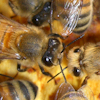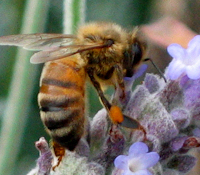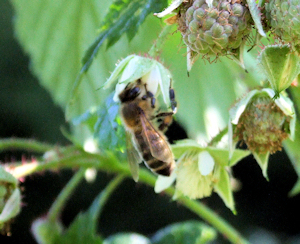Information about Honey Bees

There are over 20,000 species of Bee in the world and Honey Bees make up only a very small percentage of this with seven species and 44 subspecies. All the species can be found in the genus Apis. The Bee's origins are thought to be in Asia having originally evolved from the wasp.
The Honey Bee lives in a colony which includes the Queen, the workers, the drones and a range of immature stages of Bee. This will include the eggs, larvae and pupae (maggots) which are collectively known as the brood. The Queen has the longest body shape, her head being proportionally smaller and legs more gangly. The drone is more squarely built with huge compound eyes and the worker is smaller at half the weight with specially adapted large spoon shaped mouth parts to sculpt the wax. The worker bees are all female and cannot mate, and therefore do not reproduce.
Anatomy of the Honey Bee
The body of the Bee, like all insects, is divided into three distinct parts; the head, thorax and abdomen. The soft membranes and hard plates which connected these main sections are collectively called the exoskeleton, which as it suggests is an exterior skeleton and is made up of soft living cells under hard dead cells, an armour like coating.
Throughout the body of the Bee are scattered trachea, minuscule tubes which open to the air. The Bee uses these to transport oxygen to the parts of the body which require it, a mechanism which is not present in their blood. The oxygen is used to produce energy by oxidizing substances such as sugar which also produces carbon dioxide and water.
Because the Bees blood does not carry oxygen it has no haemoglobin and so is not red but rather a

creamy colour or nearly colourless. This carries out a number of processes such as destroying bacteria, the removal of foreign bodies and wound healing. The Bee blood fills the body and bathes the organs rather than running through tubes.
The Bee has a brain, like all insects, and a series of autonomous sub-brains called Ganglia spread throughout its body. These operate indecently gathering information about the Bees environment and can be controlled by the brain if required.
Bee eyes are very different from ours. Two large compound eyes, one on each side of the head, are made up of small simple eyes known as Ommnatida. With these the Bee can see a different colour spectrum and recognise some shapes as well as being sensitive to the polarization of light.
Swarming
The phenomenon of swarming when the colony is at its peak population is well known. The honeybee queen has evolved into a state where she can only lay eggs. She has lost completely the ability to take care of these eggs, to give them a home and defend them. These roles have become the necessary work to the workers. For honey bees to reproduce its species, it is necessary to generate further queens that must start a new colony elsewhere. The only way this can be done is to a queen leaving the hive with a band of bee workers to build and develop a new colony. In the wild helps develop extra colonies, so that those which are lost through accidents, bad weather, disease and predators can be replaced. For thousands of years swarming must have been the mechanism by which the honey bee gradually spread out from, the tropics, and adapted to other regions.
A colony that changes its queen without swarming (also known as supersedure ") will be a new colony as soon as the workers of the old queen are dead. The resulting population becomes the product of the new Queen, and will have different characteristics. This method, however, fails to increase the number of colonies and therefore does little to help the species to survive and nothing against its spread.
Before supersedure or swarming may take place one or more new queens must be produced. Queen cells are not found in the colony all the time, however, and appear only when the time is ripe for thriving supersedure to occur, or if the reigning queen is removed from the colony by the beekeeper. It must therefore be some trigger that initiates its production, and as a colony usually shows signs of the beginning to construct queen cells in the twenty-four hours after the queen being removed, the trigger must make them react quickly to her loss.
The details of this mechanism are as follows. A pheromone substance is produced by one individual queen that affects and changes the physiology, behavior, or both, of the bees. The effect only needs very small amounts of the substance, which can be eaten or just smelled or those it touches.

In this case we are dealing with a pheromone known as the "Queen substance" consisting of at least two subjects: oxydecenoic acid and hydroxydecenoic acid, the former being the same pheromone that acts as attractant for the drones when the unmated queen is on the wing. This substance is licked from the Queen and sent around the colony with the help of regular food transfer mechanism. Workers who receive more than a very small dose of queen substance in their food are prevented from making queen cells. In the normal colony for most of the year this is the position. When the queen gets older her production of queen substance goes down to about a quarter of her original production in her third year. There comes a time, in some colonies therefore where the queen is still on a lot of eggs and has built up a large force of worker bees but will not to produce enough queen substance to give an adequate dose for everyone. Inhibition of part of colony will thus cease and the need to swarm begins to grow as their Queen substance levels drop.

